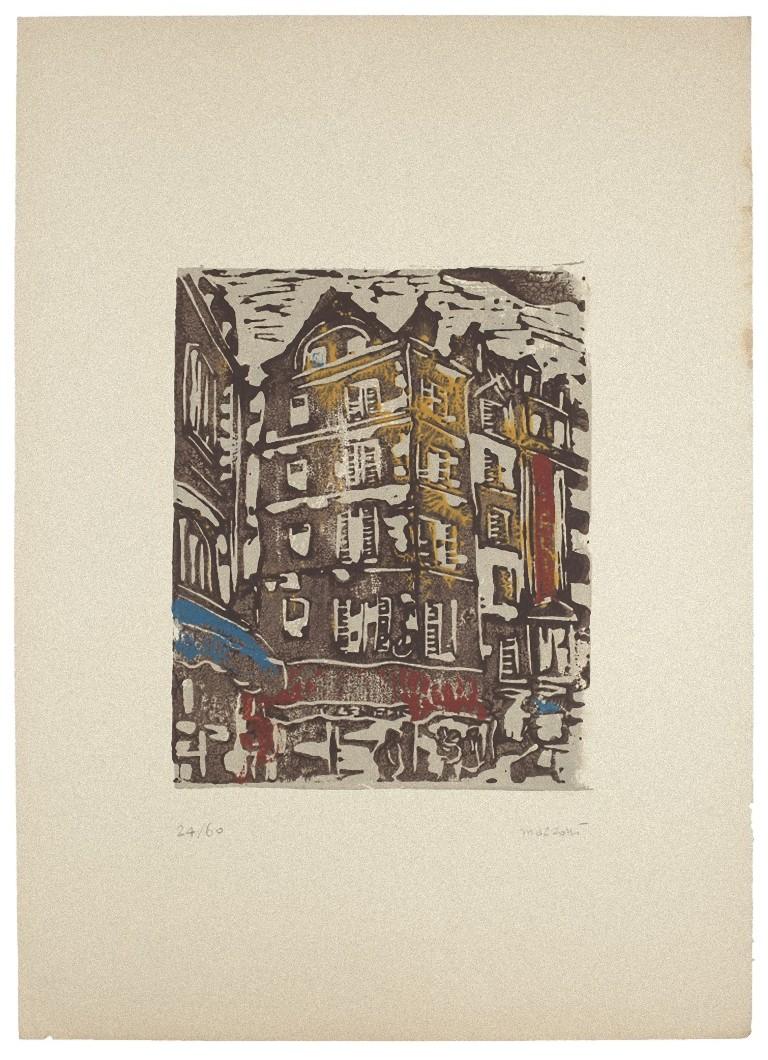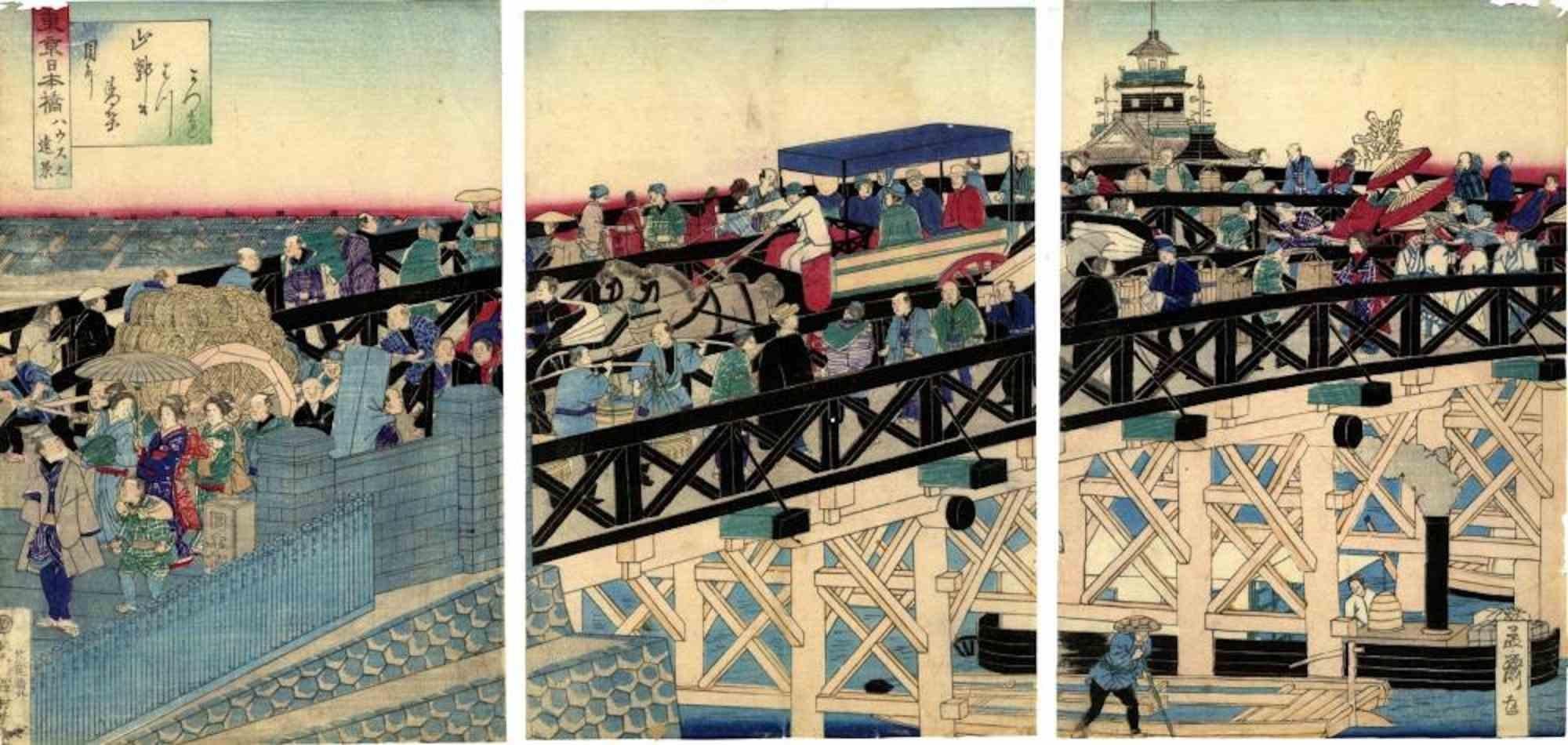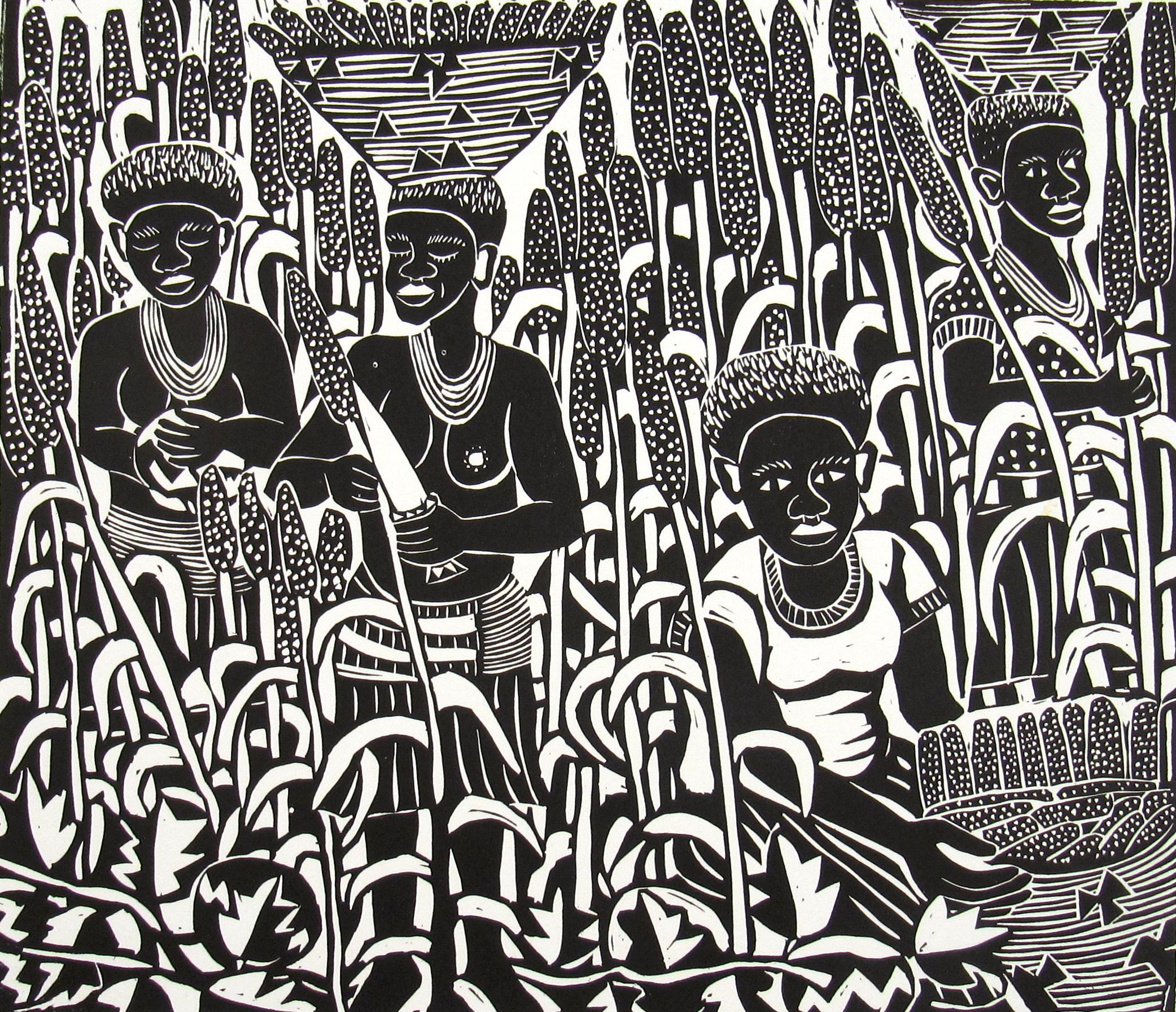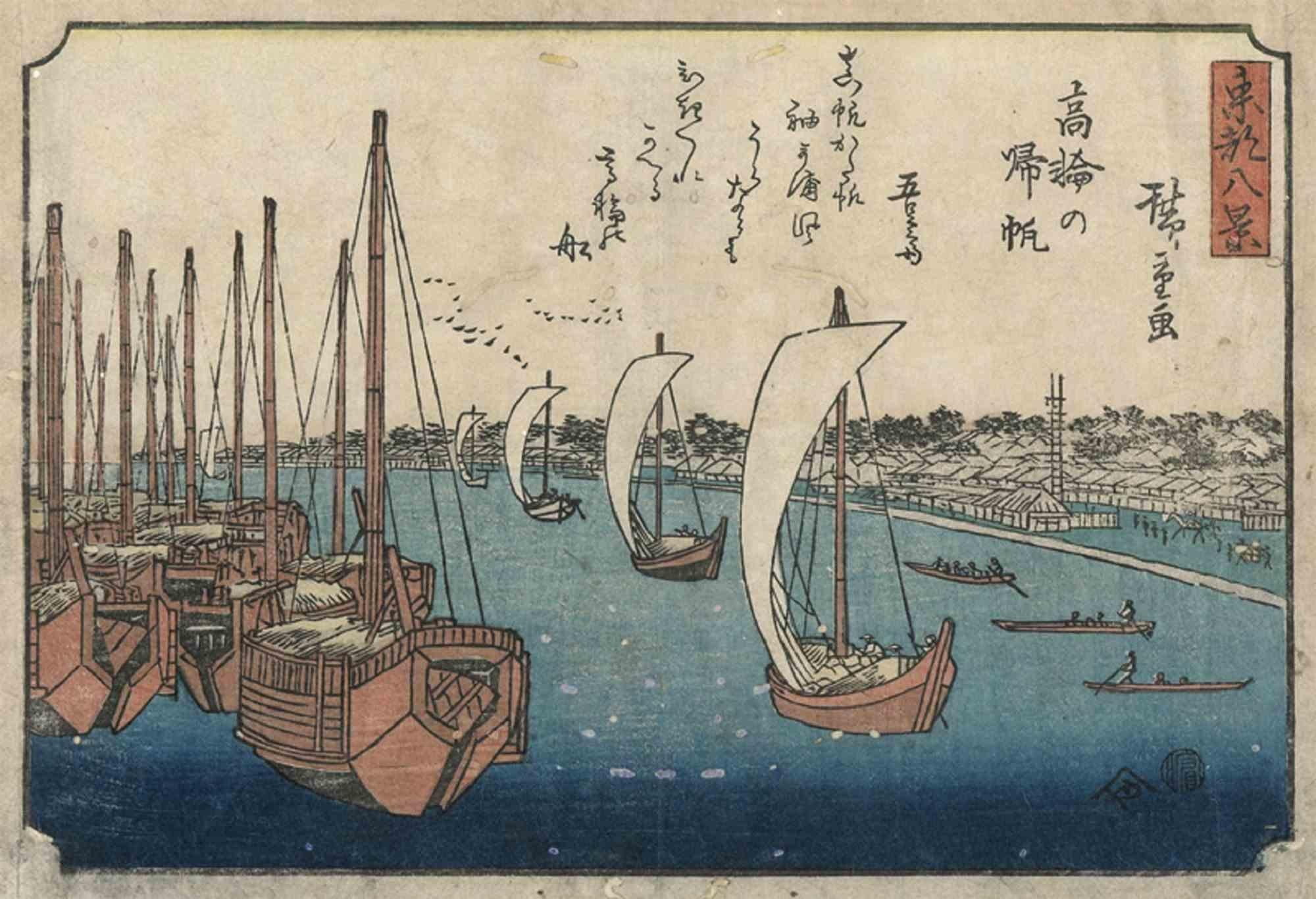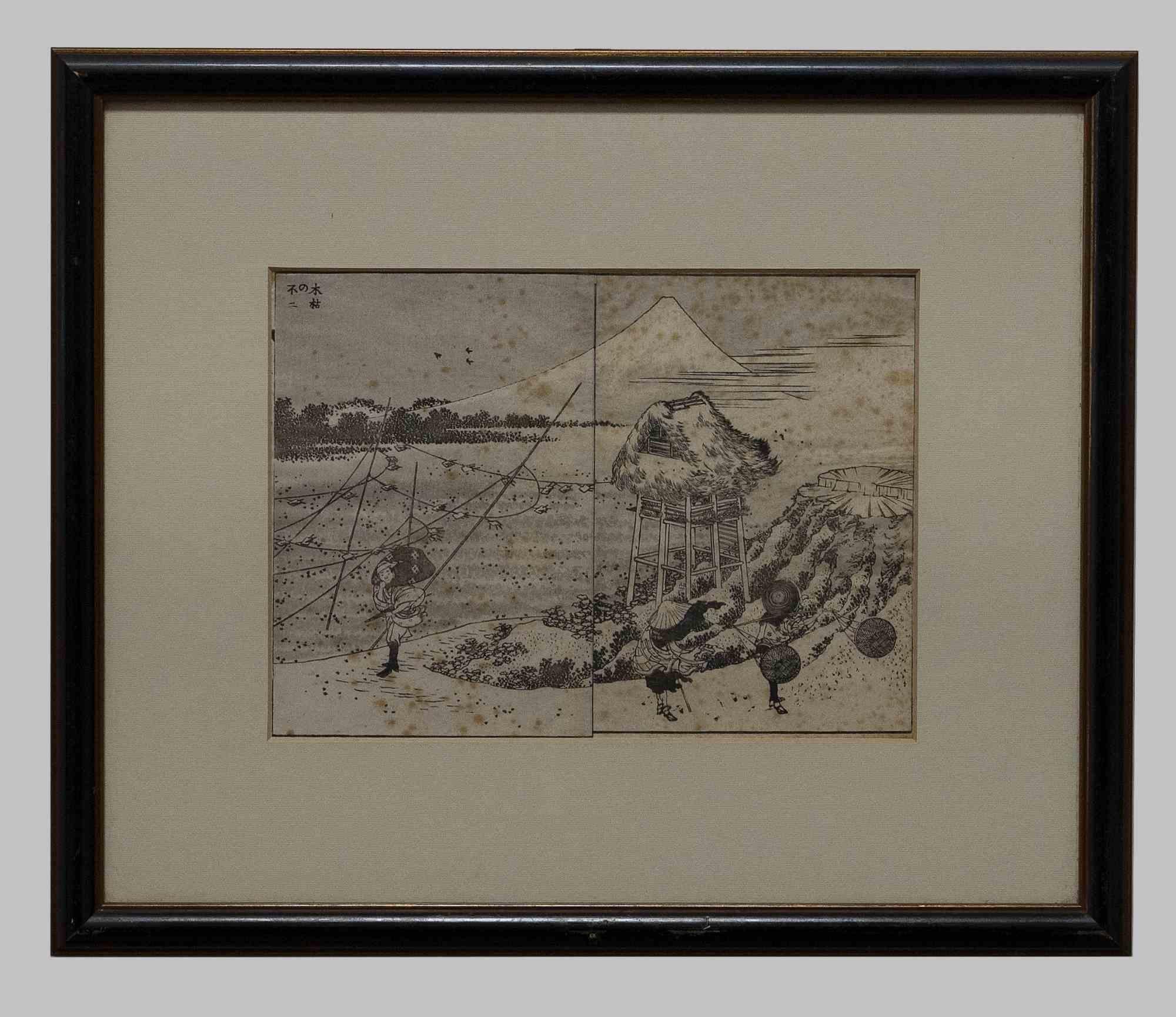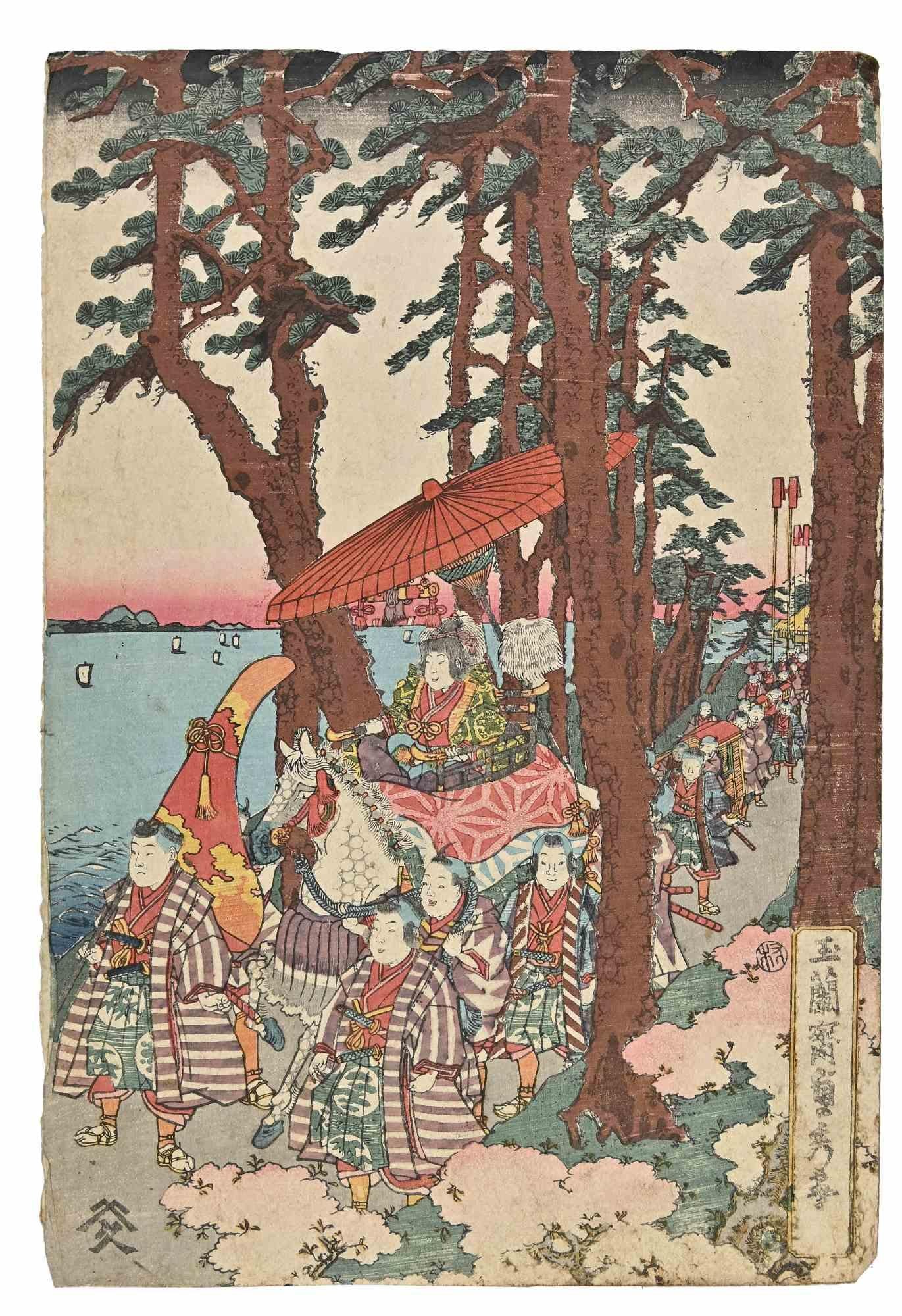Items Similar to 'Chion-in Temple Gate' from 'Eight Scenes of Cherry Blossoms' — Jizuri Seal
Want more images or videos?
Request additional images or videos from the seller
1 of 3
Hiroshi Yoshida 'Chion-in Temple Gate' from 'Eight Scenes of Cherry Blossoms' — Jizuri Seal1935
1935
About the Item
Hiroshi Yoshida, 'Chion-in Temple Gate (Sunset)' from the series 'Eight Scenes of Cherry Blossoms (Sakura hachi dai: Sakura mon)', color woodblock print, 1935. Signed in brush 'Yoshida' and in pencil 'Hiroshi Yoshida'. A superb, early impression, with fresh colors; the full sheet with margins, on cream Japan paper; an area of slight toning in the top right sheet corner, not affecting the image, otherwise in excellent condition. Marked with a jizuri (self-printed) seal, upper left margin. Self-published by the artist.
Image size 9 5/8 x 14 3/4 inches (444 x 375 mm); sheet size 10 7/8 x 16 inches (276 x 406 mm). Archivally sleeved, unmatted.
Provenance: M. Nakazawa, Tokyo.
Literature: Japanese Landscapes of the 20th century (Hotei Publishing calendar), 2001, May.
Collections: Honolulu Museum of Art, Museum of Fine Arts, Boston.
ABOUT THE IMAGE
Located in Kyoto, Chionin is the main temple of the Jodo sect of Japanese Buddhism, one of the most popular Buddhist sects in Japan, having millions of followers. The Sanmon Gate, Chionin's entrance gate, standing 24 meters tall and 50 meters wide, it is the largest wooden temple gate in Japan and dates back to the early 1600s. Behind the gate, a wide set of stairs leads to the main temple grounds.
ABOUT THE ARTIST
Painter and printmaker Yoshida Hiroshi (1876-1950) is regarded as one of the greatest artists of the Japanese 'shin hanga' (New Print) movement.
Yoshida was born as the second son of Ueda Tsukane in Kurume, Fukuoka Prefecture, a schoolteacher from an old samurai family. In 1891 he was adopted by his art teacher Yoshida Kasaburo in Fukuoka and took his surname. In 1893 he went to Kyoto to study painting, and the following year to Tokyo to join Koyama Shotaro's Fudosha private school; he also became a member of the Meiji Fine Arts Society. These institutions taught and advocated Western-style painting, greatly influencing Yoshida’s artistic development.
In 1899 Yoshida had his first American exhibition at Detroit Museum of Art (now Detroit Institute of Art), making the first of many visits to the US and Europe. In 1902 he helped reorganize the Meiji Fine Arts Society, renaming it the Taiheiyo-Gakai (Pacific Painting Association). He again traveled to the US, Europe, and North Africa in 1903-7, with his stepsister and fellow artist Fujio, whom he married on their return. From then until 1920, he achieved great success as a painter in oils and watercolor—his impeccable draftsmanship and harmonious colors receiving widespread appreciation. Yoshida’s success, coupled with his independent spirit, led him into conflict with the tradition-laden artistic establishment in Japan.
In 1920, Yoshida began to design woodblock prints for the esteemed publisher Shōzaburō Watanabe, who wanted a Western-style artist in his stable. The Kanto earthquake of September 1923 destroyed Watanabe’s workshop, and all the blocks for Yoshida’s prints and existing stock were lost. Soon after that, he returned to the US—this time to raise funds for himself and his fellow artists. In touring the western US he discovered that expertly produced prints were eagerly sought after. On his return to Japan, he established his workshop to have autonomy over his woodblock print designs.
From 1925 onwards Yoshida devoted his career principally to producing woodblock prints. He carefully supervised every aspect of the printmaking process, ensuring that his exacting standards were met. Many of his print series were inspired by his foreign travels, including those of the US, Canada, Europe, Egypt, India, Korea, and China (visited in 1936). In 1938 he went on the first of three further trips to China as an official war artist. He designed his last print in 1946 while still continuing to paint. He was the prime Japanese organizer of the Toledo Museum Exhibitions of modern Japanese prints in 1930 and 1936, including many of his own works: nine were shown in the first exhibition and sixty-six in the second. Both shows increased his popularity in the US, which led to his being widely collected in that country. His cultivation of a Western audience was further supported by his 1939 publication of the book 'Japanese Woodblock Printing' produced in English.
Yoshida’s woodblock prints are held in every major museum collection of Japanese prints including the Art Institute of Chicago, Dallas Museum of Art, Harvard Art Museums, Museum of Fine Arts Boston, Fine Art Museum of San Francisco, Cleveland Museum of Art, Metropolitan Museum of Art, Philadelphia Museum of Art, Fukuoka Art Museum (Japan), and the National Museum of Modern Art, Tokyo.
- Creator:Hiroshi Yoshida (1876-1950, Japanese)
- Creation Year:1935
- Dimensions:Height: 9.63 in (24.47 cm)Diameter: 14.75 in (37.47 cm)
- Medium:
- Movement & Style:
- Period:
- Condition:
- Gallery Location:Myrtle Beach, SC
- Reference Number:
About the Seller
5.0
Recognized Seller
These prestigious sellers are industry leaders and represent the highest echelon for item quality and design.
Platinum Seller
These expertly vetted sellers are 1stDibs' most experienced sellers and are rated highest by our customers.
Established in 1995
1stDibs seller since 2016
259 sales on 1stDibs
Typical response time: 1 hour
Associations
International Fine Print Dealers Association
- ShippingRetrieving quote...Ships From: Myrtle Beach, SC
- Return PolicyA return for this item may be initiated within 7 days of delivery.
More From This SellerView All
- Bridges of FlorenceLocated in Myrtle Beach, SCAlonzo C. Webb, 'Bridges of Florence', etching, 1929, edition 100. Signed and titled in pencil. Signed and dated in the plate, lower left. A superb, richly-inked impression, in warm ...Category
1920s American Realist Figurative Prints
MaterialsEtching
- 'Financial District', New York City — 1930s American ModernismBy Howard Norton CookLocated in Myrtle Beach, SCHoward Cook, 'Financial District', lithograph, 1931, edition 75, Duffy 155. A fine, richly-inked impression, on cream wove paper, the full sheet with wide margins (2 3/4 to 5 5/8 inches), in excellent condition. Image size 13 5/16 x 10 3/8 inches (338 x 264 mm); sheet size 23 x 16 inches (584 x 406 mm). Matted to museum standards, unframed. Literature: 'American Master Prints from the Betty and Douglas Duffy Collection', the Trust for Museum Exhibitions, Washington, D.C., 1987. Collections: Crystal Bridges Museum of American Art, Library of Congress, Metropolitan Museum of Art, Philadelphia Museum of Art, Smithsonian American Art Museum. ABOUT THE ARTIST Howard Norton Cook (1901-1980) was one of the best-known of the second generation of artists who moved to Taos. A native of Massachusetts, he studied at the Art Students League in New York City and at the Woodstock Art Colony. Beginning his association with Taos in 1926, he became a resident of the community in the 1930s. During his career, he received two Guggenheim Fellowships and was elected an Academician in the National Academy of Design. He earned a national reputation as a painter, muralist, and printmaker. Cook’s work in the print mediums received acclaim early in his career with one-person exhibitions at the Denver Art Museum (1927) and the Museum of New Mexico (1928). He received numerous honors and awards over the years, including selection in best-of-the-year exhibitions sponsored by the American Institute of Graphics Arts, the Brooklyn Museum, the Society of American Etchers, and the Philadelphia Print Club. His first Guggenheim Fellowship took him to Taxco, Mexico in 1932 and 1933; his second in the following year enabled him to travel through the American South and Southwest. Cook painted murals for the Public Works of Art Project in 1933 and the Treasury Departments Art Program in 1935. The latter project, completed in Pittsburgh, received a Gold Medal from the Architectural League of New York. One of his most acclaimed commissions was a mural in the San Antonio Post Office in 1937. He and Barbara Latham settled in Talpa, south of Taos, in 1938 and remained there for over three decades. Cook volunteered in World War II as an Artist War Correspondent for the US Navy, where he was deployed in the Pacific. In 1943 he was appointed Leader of a War Art Unit...Category
1930s American Modern Figurative Prints
MaterialsLithograph
- 'Coenties Slip' — 1920s Lower Manhattan, Financial DistrictBy Luigi KasimirLocated in Myrtle Beach, SCLuigi Kasimir, 'Coenties Slip', color etching with aquatint, 1927, edition 100. Signed in pencil. Dated in the plate, lower right. Annotated 'NEW YORK HANOVER SQUARE (COENTIES SLIP)'...Category
1920s American Modern Landscape Prints
MaterialsEtching, Aquatint
- 'Brooklyn Bridge' — 1920s view of an iconic New York City landmarkBy Luigi KasimirLocated in Myrtle Beach, SCLuigi Kasimir, 'Brooklyn Bridge', color etching with aquatint, 1927, edition 100. Signed in pencil. A superb impression, with fresh colors, on heavy, cream wove paper; with margins...Category
1920s American Modern Landscape Prints
MaterialsEtching, Aquatint
- 'Backyards of Broadway' — 1920s American Precisionism, New York CityBy Louis LozowickLocated in Myrtle Beach, SCLouis Lozowick, 'Backyards of Broadway ( Waterfront I )', lithograph, 1926, edition 10, Flint 7. Signed in pencil. A fine, richly-inked impression, on BFK Rives off-white, wove paper...Category
1920s American Modern Figurative Prints
MaterialsLithograph
- 'Peking - Paifang Gate' — Mid-Century Watanabe Color WoodcutBy Cyrus Le Roy BaldridgeLocated in Myrtle Beach, SCCyrus Le Roy Baldridge, 'Peking '25', woodblock print, published 1926. Signed, titled, dated, and annotated 'No 124' in pencil. A fine impression, with fresh, undiminished colors; the full sheet, in excellent condition. Watanabe 6 mm seal, lower right, indicating an impression printed between 1945 and 1957. Archivally sleeved, unmatted. Image size 9 5/8 x 14 5/16 inches; sheet size 10 7/16 x 15 3/8 inches. ABOUT THE IMAGE A 'paifang', also known as a 'pailou', is a traditional style of Chinese architectural arch or gateway structure. It has been theorized that the paifang gate architecture was influenced by Buddhist torana temple gates. Paifang are designed with traditional Chinese architectural motifs including multi-tiered roofs, prominent supporting posts, and gracefully arched openings. This is an unusual ukiyo-e or 'floating world' woodcut published by Watanabe Shozaburo, Tokyo, in that the subject is of an early 20th-century scene in Peking, China. ABOUT THE ARTIST Cyrus Leroy Baldridge...Category
1920s Showa Landscape Prints
MaterialsWoodcut
You May Also Like
- Houses - Woodcut by Carlo Mazzoni - 1977By Carlo MazzoniLocated in Roma, ITHouses in the city is an original woodcut realized by Carlo Mazzoni. Hand-signed by the artist in pencil on the lower right corner. Numbered on the lower-left corner. Edition 24/60....Category
1970s Figurative Prints
MaterialsWoodcut
- Nihonbashi Bridge - Woodcut Print by Utagawa Yoshitora - 1875By Utagawa YoshitoraLocated in Roma, ITScene on the Nihonbashi Bridge is an artwork realized in 1875 by Utagawa Yoshitora. Woodcut print triptych. Signed: Mosai ga. Publisher: Sawamuraya...Category
1870s Modern Figurative Prints
MaterialsWoodcut
- Elia Shiwoohamba ( Namibia, 1981 ) Harvesting Time Lino Cut African School 2006By Elia ShiwoohamaLocated in Meinisberg, CHElia Shiwoohamba (* 1981 , Windhoek, Namibia ) Harvesting Time • African School • Linoleum cut • Sheet ca. 34.5 x 43 cm (Image is smaller) • Bottom left numbered 8/50 and titled • ...Category
Early 2000s Expressionist Landscape Prints
MaterialsPaper, Linocut, Woodcut
- Takanawa no Kihan - Woodblock print by Utagawa Hiroshige - 1843-1847By Utagawa HiroshigeLocated in Roma, ITTakanawa no kihan is a modern artwork realized between 1843 and 1847 after Utagawa Hiroshige. Ukiyo-e color woodblock print from the Touto hakkei (The Eight Famous Views of the Capital of the East) series. Mounted under passepartout. The artwork depicts the port of Takanawa, a suburb of Minato in southern Tokyo, and is one of the very rare sheets by Utagawa Ando Hiroshige...Category
Mid-19th Century Modern Figurative Prints
MaterialsWoodcut
- View of Mount Fuji in Winter- Woodcut by Katsushika Hokusai - Early 20th centuryBy Katsushika HokusaiLocated in Roma, ITView of Mount Fuji in Winter is a woodcut print realized by Katsushika Hokusai in the early 19th Century, probably around 1835. From the book "Fugaku hyakkei" (100 views of Mount Fu...Category
Early 20th Century Modern Figurative Prints
MaterialsWoodcut
- Parade - Woodblock Print by Utagawa Kunisada - Mid-19th CenturyBy Utagawa Kunisada (Toyokuni III)Located in Roma, ITCelebratory Parade is an original Woodcut print realized in mid 19th century after Utagawa Kunisada. Good condition and Beautiful colored woodblock print. This wonderful modern a...Category
Mid-19th Century Modern Figurative Prints
MaterialsWoodcut
Recently Viewed
View AllMore Ways To Browse
Set Of Seals
Japanese Prints 1950
Chinese Prints Set
Print Of Cherries
Japan Cherry Blossoms
Japanese Cherry Blossoms
Buddhist Temple Art
Japan Art Cherry Blossom
Old Chinese Art Print
Egypt Temple
Wooden Temple
All Japanese Woodblock Prints
Set Of Nine Prints
Stairs Print
Old Block Prints
Vintage Calendar Print
Vintage Calendar Prints
Watanabe Prints
